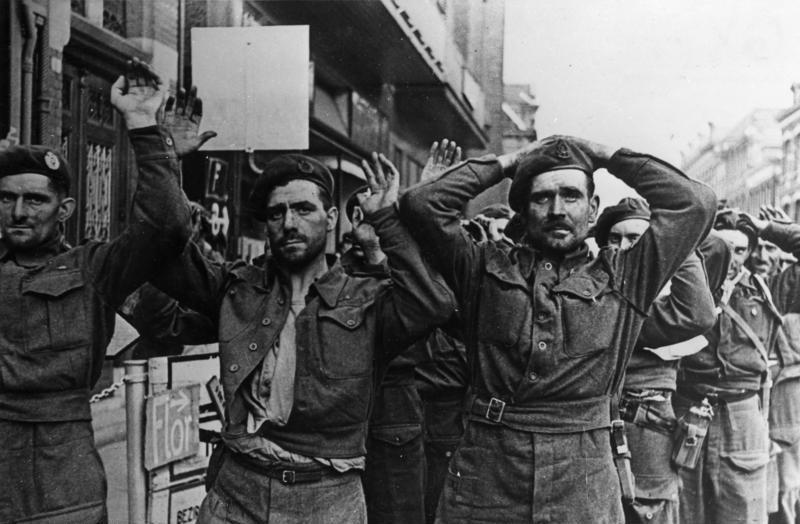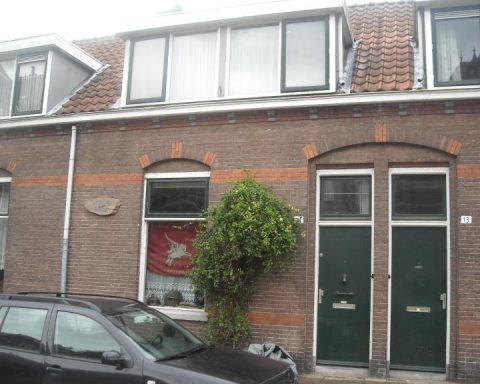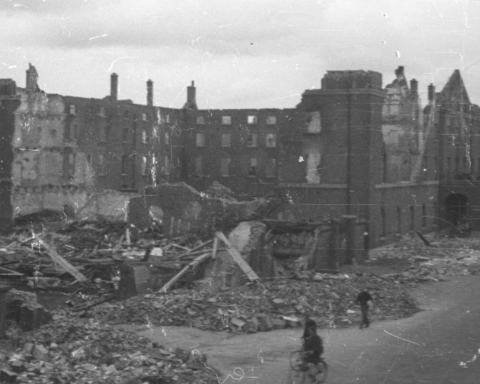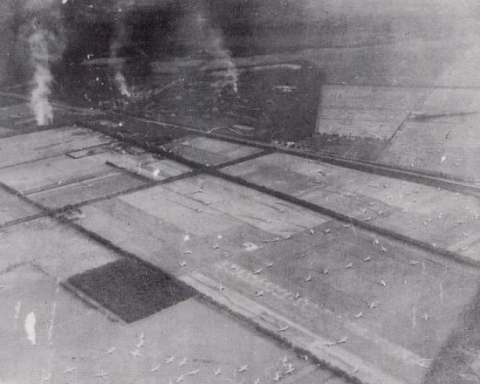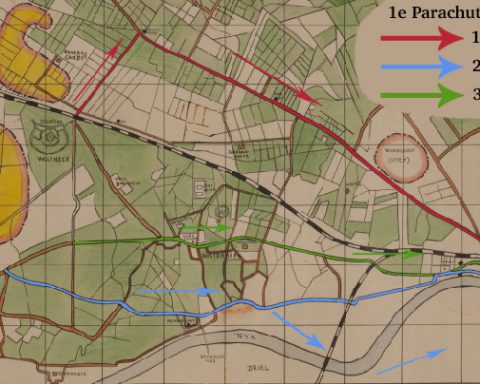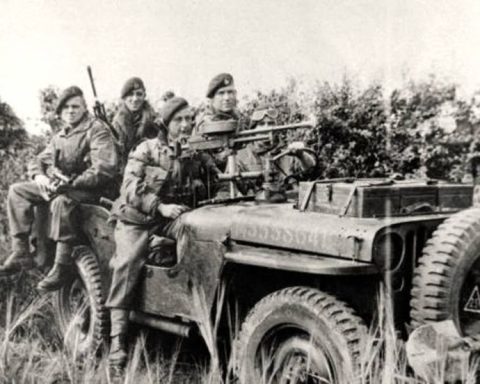If Operation Market Garden had gone according to plan, the ground troops of XXX Corps would have reached the south side of the Rhine on Tuesday, September 19, in the afternoon. But on Wednesday morning, September 20, the tanks and troops of XXX Corps were still in Nijmegen, where the Waal Bridge had yet to be captured.
Twenty kilometers to the north, the 2nd Battalion of the 1st Parachute Division under Colonel John Frost was still holding out bravely at the Rhine Bridge. 750 British paratroopers had been stubbornly occupying the north side of the Rhine Bridge for more than two days.
An attack with armored cars via the south side of the Rhine Bridge had been completely destroyed by the British . Tank attacks by SS Panzergrenadiers had been repulsed by the British. Although the number of casualties on the British side steadily increased, the British fiercely defended the buildings in their possession.
After two days the Germans decided to change their tactics. The tanks and guns around the bridge were now used to destroy the houses where the British were entrenched. The buildings were also set on fire with flamethrowers and phosphorus grenades. The Germans really wanted to regain control of the bridge so that they could send tanks and equipment to Nijmegen. The Waal Bridge was still in German hands there.
The situation on the British side was dire. The large number of dead and wounded made it increasingly difficult to resist German pressure. In addition, PIAT anti-tank shells had run out and there was a shortage of ammunition, medical supplies and water.
After three days we finally managed to establish a connection with the headquarters of the British Airborne Division in Oosterbeek. Colonel Frost explained to General Urquhart that his troops would not last much longer, but Urquhart explained that they had their own problems and were no longer able to reach the bridge. Frost then announced that they would hold out at the bridge as long as possible, in the hope that the ground troops would arrive in time.
However, Frost suspected that Operation Market Garden did not proceed as intended south of the Rhine, so he considered the chance that he would be relieved from the south to be small.
Wounded
The German attacks were concentrated on the east side of the bridge, where the British only had a few buildings in their hands on Wednesday morning. Several German engineering units had tried to install explosives from the east side of the bridge in order to blow up the bridge in case the British would indeed break through to Arnhem from Nijmegen.
A counterattack led by Lieutenant Jack Grayburn forced them back. Grayburn was killed in the counterattack. He was posthumously awarded the Victoria Cross for his bravery.
The British were now being smoked out house by house. As soon as a building threatened to fall into ruins or could no longer be defended by the flames, the British moved to one of the other buildings they still owned. During the slow German advance, many British were captured, especially wounded.
Almost all British soldiers were wounded, some worse than others. Captain Eric Mackay: “Every time I looked at them I felt a pain in my stomach. They were hollow-eyed and dirty and had red-rimmed eyes. Almost everyone had a dirty emergency bandage and you saw blood everywhere.”
The Germans at the bridge had now received reinforcement from a battalion of Tiger VI tanks. At the beginning of the afternoon, the Tiger tanks had once again set fire to the Van Limburg Stirum School, on the east side of the bridge. The school was riddled with bullets and no longer defensible. The remaining British soldiers tried to break out, but almost all the soldiers were captured by the Germans.
A German soldier wanted to throw a hand grenade through a basement window of the school, but while he had already fired the grenade, he heard groaning sounds.
“I threw the grenade at another building. Then, wary of a trap, I went down to the cellar and as I entered I said, “Hands up!” The cellar was full of wounded English soldiers. They were terrified, so I said, “It’s okay, it’s going to be okay.” I captured them and had them taken away to be cared for. They looked terrible.”
Frost injured
Late in the afternoon, Colonel John Frost was wounded in the leg. While he was conferring with Major Douglas Crawley, one of his company commanders, a mortar bomb exploded nearby, wounding them both.
Jimmy Logan, the doctor who cared for Frost, wanted to give him morphine. Frost rejected that. He wanted to stay clear. He endured the pain for as long as he could. But early in the evening he handed over command to Major Freddie Gough.
Frost was taken on a stretcher to the basement of the brigade headquarters, which served as an emergency hospital. There he finally accepted morphine and fell asleep.
When he woke up after a few hours, it was dark outside. The British had now lost all houses on the east side and on the west side of the bridge all houses directly adjacent to the bridge were also in German hands. The British resistance shrank.
Although the British still held out in the houses they still occupied, the bridge itself was now in German hands. The Germans immediately allowed the first tanks to drive over the bridge. Viktor Gräbner’s destroyed panzer column was pushed aside, and that evening German tanks set up a defensive position on the south side of the Rhine Bridge.
After the war, there was speculation that if the Allies had driven from Nijmegen to Arnhem from the newly conquered Waal Bridge that evening in the dark, they would still have been able to capture the Rhine Bridge. But this is not correct. If the Allies had done this, they would have been stopped by German tanks before the south side of the Rhine Bridge.
Ceasefire
Because the British brigade headquarters was also on fire that evening, Major Gough arranged a truce with the Germans to transfer the wounded. At the same time, all German prisoners that the British had taken were also transferred. In total, the British paratroopers had captured 150 Germans.
The injured were taken in British jeeps to the Elisabeth Gasthuis. The Germans recognized a member of the resistance who had fought alongside the paratroopers, because his hands were bandaged due to severe burns. He had tried to pick up a phosphorus bomb to throw it away. He was forced to his knees by a German officer and shot in the back of the head.
After the truce ended, fighting resumed in the tiny British sector. The British now owned only a few houses, and those houses were all on fire. It was decided to break out into small groups.
The battle at the bridge was now over. All the British at the bridge were dead or captured.
The British had to occupy the Rhine bridge for 48 hours before they were relieved by the tanks of XXX Corps. For more than 72 hours, the British fought doggedly and fanatically against a much stronger enemy force that only managed to drive out the British with tanks and armored cars after many efforts and casualties.

